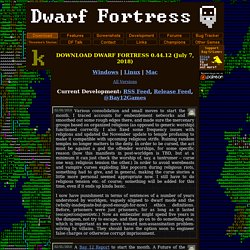

DF2014:Adventure mode quick reference. DF2014:Adventurer mode. This is a detailed reference guide for Adventurer Mode.

For a tutorial see the Adventure Mode Quickstart Guide. See Adventure Mode quick reference to quickly look up key commands. In Adventurer Mode (also called "adventure mode") you create a single adventurer (dwarf, human, or elf) who starts out somewhere in one of your generated worlds. You can learn about what ails the world and go on quests to end those troubles, venture into the wilderness to find caves, shrines, lairs, abandoned towers, and other towns and settlements. You can even visit your abandoned and retired fortresses and take all the precious items you yourself once created. Unlike Fortress mode, Adventurer Mode is a sort of advanced open world version of rogue or nethack taking place in the same procedurally generated worlds used for Fortress Mode.
You can play Adventurer mode in any world that has a civilization with the ADVENTURE_TIER token (which are elf, dwarf, and human in unmodded raws). [Leave feedback] [edit] Body. Roguelike Primer: Best In Genre For Beginners & Veteran. Rocedurally generated dungeon crawling seems to get more popular with each passing year, all building on top of a template first featured way at the start of the 80s.

Development jams are held to create them en-masse (this year’s 7DRL challenge kicks off this Saturday), and they’re becoming increasingly commercially viable, thanks to accessible graphical entries in the genre, such as Dungeons of Dredmor, and action-hybrids, like The Binding Of Isaac, leading the way. With so many out there, and aimed at such a wide range of player-bases, it’s hard to know where to start, or even what you’re looking for.
“The roguelike is a sub-genre of role-playing video games, characterized by level randomization, permanent death, and turn-based movement. Most roguelikes feature ASCII graphics, with newer games increasingly offering tile-based graphics. Games are typically dungeon crawls, with many monsters, items and environmental features. Ultima Ratio Regum: The Roguelike. We’re now just a week away from releasing version 0.5!

This version sees the addition of feudal cities & towns, nomadic fortresses and hunter-gatherer settlements to the world map; the creation of colonies by civilizations so inclined; an encyclopedia function that tells you everything about the world you’ve so far learned; a number of generated in-game histories which hint towards NPCs, items and plot points of interest; several tens of thousands of possible family sigils along with family trees for important houses; distinct flags for each type of civilization, and symbols for religions and cults; and various other small fixes, tweaks, memory/speed optimizations, etc etc.
This week’s entry is going to be a summary of what’s happened in the last week, then next week – on the 12th – I’ll be releasing 0.5! This in turn raised several things I’ll need to take account of for the next release, 0.6, when I’ll be generating the interiors of cities, towns, fortresses and settlements! Wilderness Survival Roguelike Game. Bay 12 Games: Dwarf Fortress. 02/06/2019 Various consolidation and small moves to start the month.

I traced accounts for embezzlement networks and smoothed out some rough edges there, and made sure the mercenary groups based on organized religions (as opposed to generic worship) functioned correctly. I also fixed some frequency issues with religions and updated the November update to temple profaning to make it compatible with upcoming religious strife. Ruining random temples no longer matters to the deity. In order to be cursed, the act must be against a god the offender worships, for some specific reason (how this manifests in post-worldgen is TBD, but at a minimum it can just check the worship of, say, a tantrumer -- curse one way, religious tension the other.) In order to avoid werebeasts and vampire curses exploding like popcorn during religious riots, something had to give, and in general, making the curse stories a little more personal seemed appropriate now.